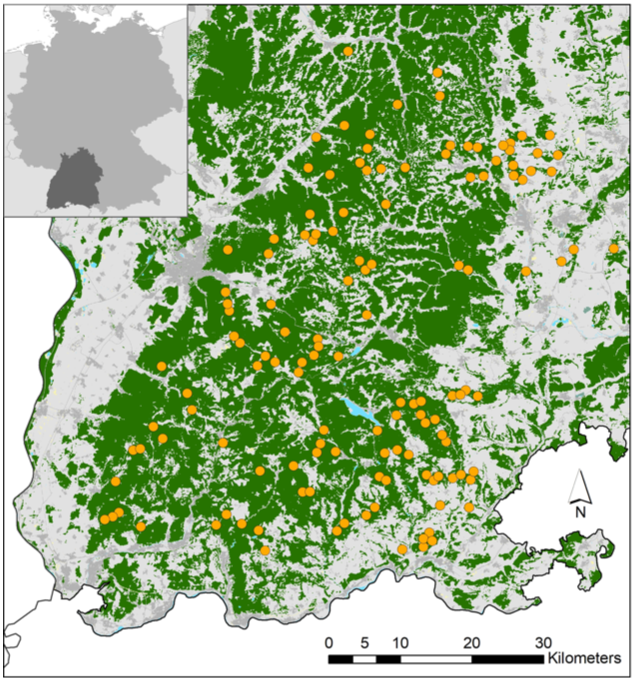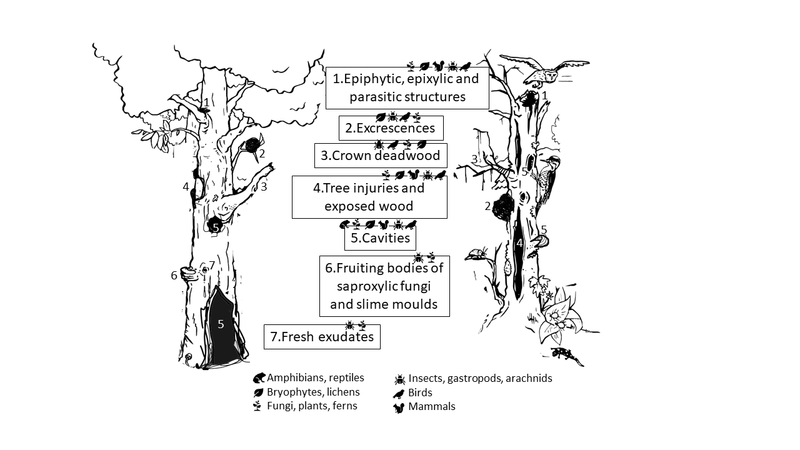The role of microhabitats on trees, or tree-related microhabitats
When it comes to supporting biodiversity and wildlife in temperate European forests, it turns out that the type of tree matters – a lot. So-called habitat trees, whether alive or dead, provide the ecological and physical characteristics used by a wide range of forest-dwelling organisms, including bryophytes, lichens, insects, and birds. Many species use tree-related microhabitats for foraging, breeding, or nesting, and some specialist species require them for their very survival.
Indeed, tree-related microhabitats (TreMs) are so important that conservation scientists and forest managers pay close attention to how many exist, how different they are, and how they complement each other. Such questions offer important insights in understanding their value for organisms present in forests. In unmanaged forest systems, habitat trees and their microhabitats are present in high numbers and with great diversity. However, in Central Europe, a long history of commercial forestry has tended to simplify and homogenize forests to better accommodate societal needs for timber– a process that has come at the expense of the quality of resources and microhabitats found on trees.
The deliberate retention of habitat trees and deadwood has become increasingly popular, as a practice that complements existing conservation efforts and maintains populations of protected forest species. While deadwood retention is rather straightforward, selection of habitat trees is challenging for practitioners, due to such trees' low occurrence and the relative novelty of the practice in Central European forests.
So which habitat trees to retain?
Last September, scientists at the University of Freiburg (Albert-Ludwigs-Universität, Freiburg) published a study in the European Journal of Forest Research that shed more light into these vital tree-related microhabitats. As part of Conservation of Forest Biodiversity in Multiple-Use Landscapes of Central Europe (ConFoBi), a research training group in the Faculty of Environment and Natural Resources that is funded by the German Science Foundation, the researchers investigated how exactly habitat trees support more, or different types of, TreMs in the Black Forest region.
In order to understand TreMs, the researchers first set out to understand the composition differences between living and dead habitat trees. They compared their TreM richness, abundance, and composition while taking in account the influence of their species, dimension, and wood decay. They also asked how living and dead habitat trees complement each other in providing microhabitats.
“The microhabitats that form on living or dead trees are likely to differ, since the tree form and its wood characteristics change after its death," said Andreea Petronela Spînu, a research scientist in ConFoBi and the lead author of the study. "Therefore, living and dead trees can together offer diverse assemblages of microhabitats in forests. These so-called 'complementarities' of trees and their microhabitats have not been studied so far."
It was important to investigate those differences and see what happens with the microhabitats if both living and dead trees are retained in managed forests, she added.
At the heart of the study, the researchers sought to understand how different retention strategies, in relation to habitat trees and TreMs, could provide distinct outcomes. Such insights into retention strategies could help forest managers and conservation scientists maximize biodiversity and wildlife habitat.
"An important goal of our research was to help practitioners by offering recommendations on how to secure diverse and abundant microhabitats in the long term," said Spînu.
On the hunt for Black Forest habitat trees
Across 133 one-hectare plots in the Black Forest region, the researchers set out to assess microhabitat composition in both living and dead trees. Using linear mixed models, they were able to estimate what conditions allow for TreM occurrence. Across the plots, the main tree species found were Norway spruce (Picea abies), European beech (Fagus sylvatica L.), and Silver fir (Abies alba), and most trees were healthy and living with relatively few dying or dead trees.
In each study plot, the TreMs were surveyed on the 15 largest living trees and 15 dead trees. Large trees were the focus, since previous research has shown that the width of the trunk strongly tracks with TreM richness and abundance. From above, remote sensing images were used to identify the largest crowns, or tree tops, and thereby find the biggest trees.
The microhabitats on trees were classified according to an already established typology, one that both considers morphology and biodiversity-supporting potential. The scientists looked at the associations between microhabitats and tree identities, defined by the tree species and its living or dead status.
Understanding microhabitat abundance and richness
The findings were striking: the abundance, richness, and composition of the tree microhabitats was widely variable across the tree identities (for example living Norway spruce and dead European beech). Tree identity and diameter together seemed to be the factors that most drive the richness and abundance of microhabitats.
Specifically, the greatest richness and abundance of microhabitats was found on dead European silver firs, especially those of larger diameters. Notably, silver firs also seemed to offer critical woodpecker habitat. Although dead European silver firand Norway spruce trees offer similar numbers of TreMs, their microhabitat assemblages differ. In addition, broadleaf tree species were found to play a vital role in supporting unique TreMs that numerous forest-dwelling species require.
Among dead trees, the abundance and richness of microhabitats also depended largely on the stage of the wood decay. TreMs appeared to improve with tree diameter among dead trees that were rottener. On the other end of the spectrum, various living coniferous species that are common in the area – specifically, Scots pine, European larch, and Douglas fir – supported fewer and less diverse microhabitats.
One possible reason that silver firs supported many microhabitats could be due to their wood properties and physiology. Since deadwood logs of silver fir decay slowly, particularly in colder areas, snags could have lasted long and developed TreMs throughout more stages of life and decay.
The findings of this study strongly suggest that dead trees alone do not provide a substitute for the habitat functions that living trees offer. Rather, dead trees appear to complement living habitat trees in key ways – most notably, by providing more diversity of microhabitats across the stand.
From the research, scientists might further advance retention forestry practices. “So far, both habitat trees and their TreMs have been mostly accounted for in numbers rather than according to their functions and how they can complement one another,” said Spînu. “Our study highlights how a combination of trees of various properties – specifically, species, living-dead status, decay stage, and size – can provision abundant and diverse microhabitats in the forests.”
European forests could benefit from a slight shift in thinking around retention practices. The authors note that managers, rather than focusing only on how many trees per hectare to preserve, should focus on securing microhabitats on living and dead trees of various species and functions. A variety of tree identities can support a wider range of complementary microhabitats, and therefore support the populations of forest-dwelling species.
Key takeaways
- While dead A. alba offered the highest TreM richness and abundance, their microhabitat profiles (or assemblages) were different than those on living broadleaf trees.
- A variety of dead tree sizes and stages of decay are critical for TreM provision.
- However, TreM abundance, richness, and composition was widely variable and depended heavily on the species and vitality status.
- Therefore, optimal retention strategies would focus on retaining a mix of living and dead trees, with a focus on many complementary types of microhabitats.






